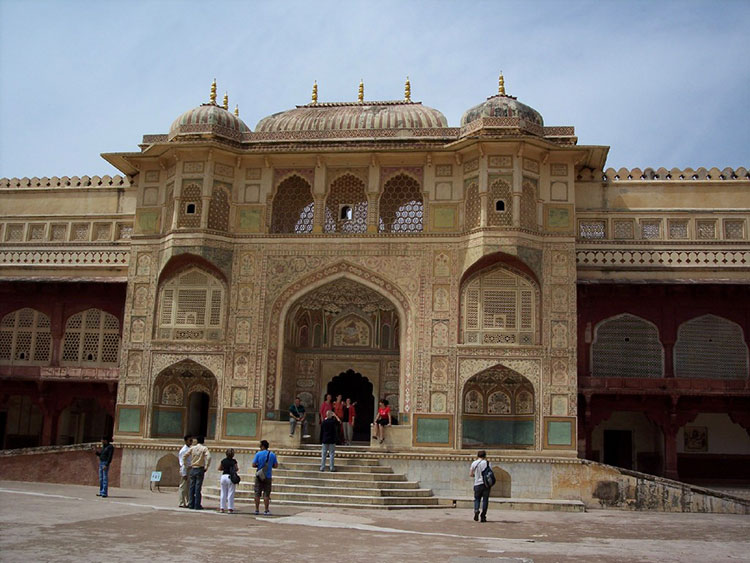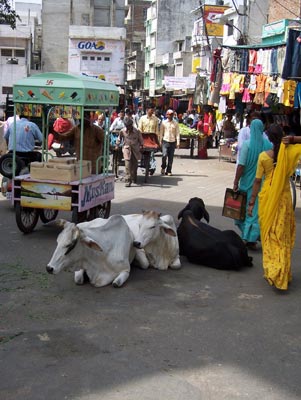Rajasthan’s palaces and other treasures
This item appears on page 86 of the October 2008 issue.
part 2 of 4 on India & Nepal
Rajasthan is India’s most popular visitor destination, with its triangular route of Udaipur, Jodhpur and Jaipur being easily accessible by road from Delhi and Agra. My May 2008 road journey through Rajasthan, hosted by SITA World Tours, focused on these three equally intriguing destinations.
For the most part, Rajasthan is a dry and dusty state, stretching to Pakistan on the west. Much of its wealth is due to its strategic trade route location in previous centuries. Rajasthan is very dependent on annual monsoons, which have failed in recent years, creating much hardship throughout the state and most of central India.
The former royals of Rajasthan have turned many of the old palaces into hotels, making it possible for visitors today to experience the romantic aura of bygone classic India. Many of the combatant Rajput rulers’ lifestyles evolved into extravagant displays of palace-laden pleasure once they accepted the protection offered under British rule.
Udaipur — the Udaivilas experience
The romantic lake city of Udaipur was my first stop in Rajasthan. On arrival from Bombay on a morning flight, I checked into the lakeshore Oberoi Udaivilas, consistently rated among the top hotels in the world. (Based on a 2-night stay, standard room rates range from approximately $475 to $600 per night, double occupancy.)
Located on the hillside shoreline of Lake Pichola, this luxury property is not an old restored palace as it first seems but a new creation impeccably designed as a traditional palace, replete with abundant flowing fountains, pavilions, soaring domes and opulent interiors adorned with marble and artifactual splendor.
There was a range of villas and suites, each with a private patio with either a garden or lake view and many with patio pool access. An adjoining nature reserve added to the ambience, and I enjoyed viewing spotted deer and a wide variety of birdlife from the pool deck overlooking the lake.
The impeccable service, the range of excellent dining options and the spa all are part of what makes the Udaivilas a destination unto itself.
My exploration of compact Udaipur began in late afternoon with an adventurous SUV journey through the narrow winding streets and seemingly impassable alleys that functioned as thoroughfares in Old Town.
In this environment, an amazing amalgam of humans, vehicles, cattle, water buffalo, donkeys, dogs and other creatures equally shared the streetscape and right-of-way with a space consciousness and lack of concern that simply do not translate in Western terms. It was excellent preparation for what I would come to experience as the norm in the following weeks.
This first evening culminated in having my driver, Surya, direct me to the Ambari Restaurant, whose lakefront-dining patio overlooked the huge City Palace and Lake Palace Hotel in a twinkling night-lit setting. My fish masala with accompaniments and beer was an excellent value at $10.
Touring Udaipur
The next morning, my touring focused on Udaipur’s well-maintained City Palace, white and majestic, dominating the city skyline. Surrounded by crenellated walls and overlooking an extensive esplanade lined by archways, it is a merging of pavilions, courtyards, corridors and hanging gardens, all creating a flowing fusion of architectural grandeur.
My guide, Shakti, took me to Jagdish Mandir (1651), Udaipur’s largest and most splendidly ornate temple, where we were able to meld with the locals for a meditative and inspiring cavalcade of chanting, bells and music.
Udaipur’s aesthetic lakefront charms today attract a continuous stream of repeat visitors and have secured the city’s popularity as a filming location for India’s huge movie industry.
During my second evening in Udaipur I had the chance to tour and dine at the Grand Laxmi Vilas Palace Hotel, set amid spacious, landscaped grounds overlooking Udaipur’s other lake, Fateh Sagar.
The completely restored historic property reveals the former royal, guest-palace style of its 1932-1934 origins. My 5-course, traditional Indian dinner featuring fish curry was perhaps the finest dining experience of my entire journey.
The following day, during our long, hot road journey to Jodhpur, we stopped at Ranakpur to visit what is regarded as the finest preserved Jain temple in India.
Ranakpur’s main temple dates back to 1439 and features 29 halls and 1,444 carved pillars, no two of which are the same. In the midday sun, the combination of light and shadow mesmerizes the senses. All the more remarkable is its very isolated location, making the construction of this human masterpiece difficult to conceive.
On to Jodhpur
The 500-year-old walled city of Jodhpur is India’s sunniest. Rising from the dusty Thar Desert, the blufftop, 16th-century fortified bastion Fort Meharangarh towers over the city and its surrounds.
The fort has indulged and endured many incarnations over the centuries, combining its historic strategic defense role with the refined, elegant tastes of its daring Rathore Rajput rulers. Touring the extensive grounds with my guide Mahindra, I explored palaces, courtyards and museums, gaining a true sense of the evolving life and times of early Jodhpur.
Below the fort, one can explore the compact Old City on foot or by rickshaw, getting a feel for the blending of traditional and modern Jodhpur and its varied lifestyles today. Jodhpur is famous for its range of quality crafts, including textiles and traditional block painting. It also is the main center for polo in India, hosting a popular, festive tournament annually in early December.
Umaid Bhawan Palace
It was my distinct pleasure to be accommodated in Jodhpur at the Umaid Bhawan Palace, one of India’s finest and most extravagant palaces. Built between 1929 and 1944, the palace combines strict purdah tradition with European 1930s Art Deco design and furnishing, with accents reflecting Rajput royal taste.
The Palace is today divided into a private palace (still occupied by royal family descendants), a museum and a luxury hotel, the Taj Umaid Bhawan Palace.
In my two days in residence, I was able to tour the museum and enjoy the fine dining, pool, spa facilities and unimpeachable service. Guests really are made to feel like royals as is the hotel’s stated intention. One can quickly become quite accustomed to dining on the Palace terrace, an experience which is graced by the strutting and occasional serenading of regally adorned resident royal peacocks.
Jaipur’s forts and palaces
On arrival in Jaipur, I was struck by the sense of openness and light that pervaded Rajasthan’s largest city. Built on a grid system, it is definitely easier to navigate than most cities in India.
Jaipur is often refered to as the “Pink City,” so ordained when all the houses in the Old City, including Hawa Mahal, the city’s central landmark, were painted pink to honor the 1905 visit of the Prince of Wales.
My initial exploration with my guide Arun focused on the City Palace (1727 origin) with its extensive collection of fabrics, costumes, paintings, carpets and, particularly, weaponry. Later we visited what is purported to be the world’s largest sundial, which is amazingly accurate… as long as the sun is shining.
Appearing to be the only foreigner present, I was able to lunch at a very popular local Indian restaurant, the Four Seasons, where for $6 I enjoyed two vegetarian main courses and soup.
The most famous and popular regional visitor attraction, just outside of Jaipur, is the 12th-century Amber Fort and Palace. Its grand, dominating hillside walls encompass a fascinating history of alliances, which began with the Mughals in 1562 and resulted in wealth and prestige for its stream of rulers.
Our touring of the vast Amber complex included the Hall of Public Audience; the Palace of Mirrors, inlaid with millions of tiny, glistening mirrors; landscaped gardens, and far-reaching views over the surrounding hills and valleys. Today it is possible to ride elephants to the gate entrance.
Rambagh Palace
Once again I was fortunate to enjoy palace residential life, this time at the Rambagh Palace, now part of the luxurious Taj hotel group. An evening champagne tour of the grounds revealed that the Palace originally was built as a hunting lodge before being transformed into a playground for royals and adorned with extensive English gardens and fountains.
My tour ended in the Polo Bar, whose walls chronicled the regal local history of the sport. A Romanesque indoor/outdoor pool and spa added to my experience and the overall Rambagh Palace allure.
On my first evening in Jaipur I had an opportunity to dine at Jaipur’s other palace hotel, the Taj Jaimahal Palace, which seemed as impressive as the Rambagh Palace.
In my next column I will report on my continuing journey, onward into central India.
India information
For information on independent travel and a wide range of tours in India, contact SITA World Tours (16250 Ventura Blvd., Ste. 300, Encino, CA 91436; phone 800/421-5643, e-mail sitatours@sitatours.com or visit www.sitatours.com).
Keck's Beyond the Garden Wall
❝Perhaps revealed no better in any place
are such extremes of humanity
bound by truced fragments
to form the fragrant sum ❞
— Randy musing on the vibrant extremes experienced by visitors to Rajasthan



